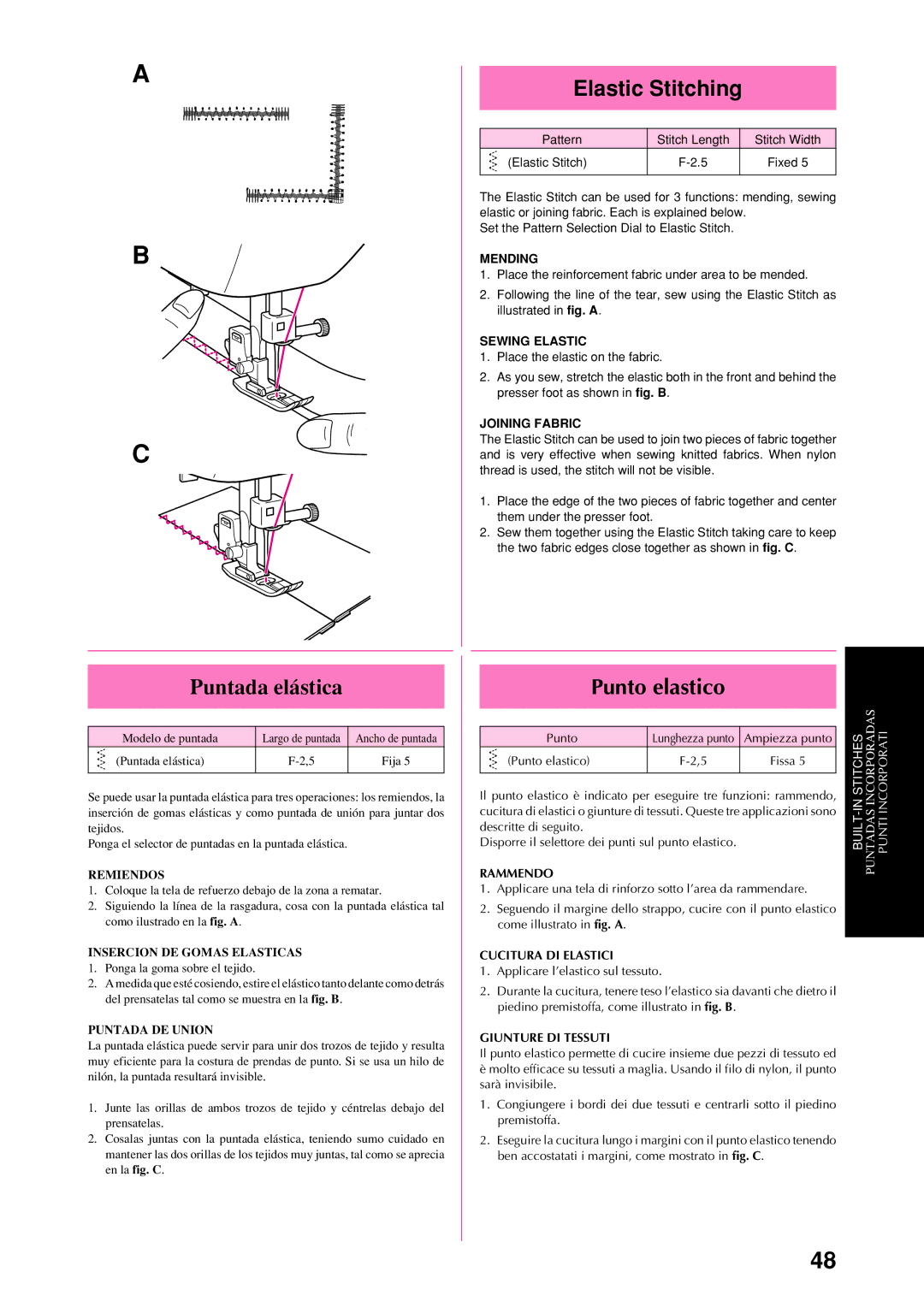
A
B ![]()
C
Puntada elástica
Modelo de puntada | Largo de puntada | Ancho de puntada |
(Puntada elástica) | Fija 5 | |
|
|
|
Se puede usar la puntada elástica para tres operaciones: los remiendos, la inserción de gomas elásticas y como puntada de unión para juntar dos tejidos.
Ponga el selector de puntadas en la puntada elástica.
REMIENDOS
1.Coloque la tela de refuerzo debajo de la zona a rematar.
2.Siguiendo la línea de la rasgadura, cosa con la puntada elástica tal como ilustrado en la fig. A.
INSERCION DE GOMAS ELASTICAS
1.Ponga la goma sobre el tejido.
2.A medida que esté cosiendo, estire el elástico tanto delante como detrás del prensatelas tal como se muestra en la fig. B.
PUNTADA DE UNION
La puntada elástica puede servir para unir dos trozos de tejido y resulta muy eficiente para la costura de prendas de punto. Si se usa un hilo de nilón, la puntada resultará invisible.
1.Junte las orillas de ambos trozos de tejido y céntrelas debajo del prensatelas.
2.Cosalas juntas con la puntada elástica, teniendo sumo cuidado en mantener las dos orillas de los tejidos muy juntas, tal como se aprecia en la fig. C.
Elastic Stitching
Pattern | Stitch Length | Stitch Width |
(Elastic Stitch) | Fixed 5 | |
|
|
|
The Elastic Stitch can be used for 3 functions: mending, sewing elastic or joining fabric. Each is explained below.
Set the Pattern Selection Dial to Elastic Stitch.
MENDING
1.Place the reinforcement fabric under area to be mended.
2.Following the line of the tear, sew using the Elastic Stitch as illustrated in fig. A.
SEWING ELASTIC
1.Place the elastic on the fabric.
2.As you sew, stretch the elastic both in the front and behind the presser foot as shown in fig. B.
JOINING FABRIC
The Elastic Stitch can be used to join two pieces of fabric together and is very effective when sewing knitted fabrics. When nylon thread is used, the stitch will not be visible.
1.Place the edge of the two pieces of fabric together and center them under the presser foot.
2.Sew them together using the Elastic Stitch taking care to keep the two fabric edges close together as shown in fig. C.
Punto elastico
|
|
| INCORPORADASPUNTADAS INCORPORATIPUNTI | ||
Punto | Lunghezza punto | Ampiezza punto | |||
|
| ||||
(Punto elastico) | Fissa 5 |
|
| ||
|
|
|
|
|
Il punto elastico è indicato per eseguire tre funzioni: rammendo, cucitura di elastici o giunture di tessuti. Queste tre applicazioni sono descritte di seguito.
Disporre il selettore dei punti sul punto elastico.
RAMMENDO
1.Applicare una tela di rinforzo sotto l’area da rammendare.
2.Seguendo il margine dello strappo, cucire con il punto elastico come illustrato in fig. A.
CUCITURA DI ELASTICI
1.Applicare l’elastico sul tessuto.
2.Durante la cucitura, tenere teso l’elastico sia davanti che dietro il piedino premistoffa, come illustrato in fig. B.
GIUNTURE DI TESSUTI
Il punto elastico permette di cucire insieme due pezzi di tessuto ed
èmolto efficace su tessuti a maglia. Usando il filo di nylon, il punto sarà invisibile.
1.Congiungere i bordi dei due tessuti e centrarli sotto il piedino premistoffa.
2.Eseguire la cucitura lungo i margini con il punto elastico tenendo ben accostatati i margini, come mostrato in fig. C.
48
